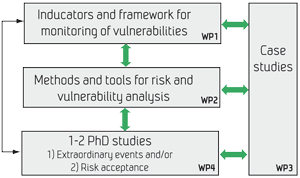
Vulnerability and security in a changing power system
Research topics
The project partly addresses three areas in the RENERGI call: Energy systems, Policy tools and Energy market, with the objectives of providing a framework for dealing with vulnerabilities and enhanced methods for power system risk and vulnerability analysis.
To meet the above described challenges several research tasks are defined. Each task will be addressed in a work package (WP) as described below and shown in the figure. The tasks will be solved in a multidisciplinary co-operation, requiring competence from power system engineering and social sciences.

Indicators and framework for monitoring vulnerabilities (WP1)
WP1 will address the need for indicators and methodical framework that can be used to measure, monitor and classify vulnerabilities and thereby enhance the understanding of vulnerabilities in electric power grids, e.g. related to the degree of utilization, degree of backup supply, extreme weather, societal costs of interruptions etc. The proposed activities are:
- Describe scenarios for a changing power system, enabling the identification of threats, vulnerabilities and risks and the need for analytical tools
- Identify and analyse causal relations for vulnerabilities with respect to different types of hazards and threats (ageing/ technical condition, exposure to extreme weather conditions, strained power balance etc.)
- Describe data needed to measure and monitor selected vulnerabilities
- Create indicators for selected vulnerabilities, to be used in the vulnerability management and for power system planning and operation purposes
- Identify needs for models and methods to quantify defined indicators.
Methods and tools for risk and vulnerability analysis (WP2)
In WP2 methods and tools for enhanced power system risk and vulnerability analysis will be developed. The work will focus on assessment of the level of security of supply and risk of unwanted events. This will provide a basis for implementing the indicators and framework in WP1 for different purposes regarding planning and operation of the power system. The proposed activities are:
- Develop methods for quantification, classification, comparison and evaluation of vulnerabilities.
- Evaluate different methods and tools to identify critical contingencies with emphasis on extraordinary events, i.e. unwanted events with potentially severe consequences.
- Develop methods for risk based security assessment to be used in network operation and for planning purposes in a changing power system.
- Evaluate possibilities for dealing with uncertainties in various parameters.
Case studies and applications (WP3)
This WP will perform case studies to support WP1 and WP2 and to demonstrate the use of indicators and methods established. Expected results from this WP are:
- Quantification and demonstration of the application of vulnerability indicators and methodical framework.
- Illustrative use of results in risk and vulnerability analysis.
- Illustrative use of results in power system planning and operation.
Education and building of new knowledge (WP4)
- through 1 - 2 doctoral (PhD) studies within one of or both the following topics
4.1 Models and methods for analysis of extraordinary events
The study will be performed from a TSO point of view to develop models and methods for risk analysis of extraordinary events with high impact on society and low probability (HILP).
- Understanding the risk of HILP events due to e.g. extreme weather, sabotage etc.
- Taking account of power system behaviour, different operating conditions and risk of wide-area interruptions.
- Studying system protection and emergency control solutions to reduce this risk as well as methods for efficient and secure restoration to minimize the societal impact.
- Evaluating integration of developed methods in operational tools at the control centre.
4.2 Risk attitudes and acceptance criteria related to wide-area interruptions
The study will be performed from a stakeholder point-of-view (energy authorities, TSOs, network companies, end-users) and for different scenarios, regarding for instance:
- Which level of security of electricity supply is required/chosen for the different stakeholders for fulfilling their needs?
- What is an acceptable level of interruptions for the different stakeholders and what is the willingness to pay for an acceptable level?
- How are the findings compared with other critical infrastructure sectors?
The approach and the final scope of the study will be defined in co-operation with relevant partners in the project.